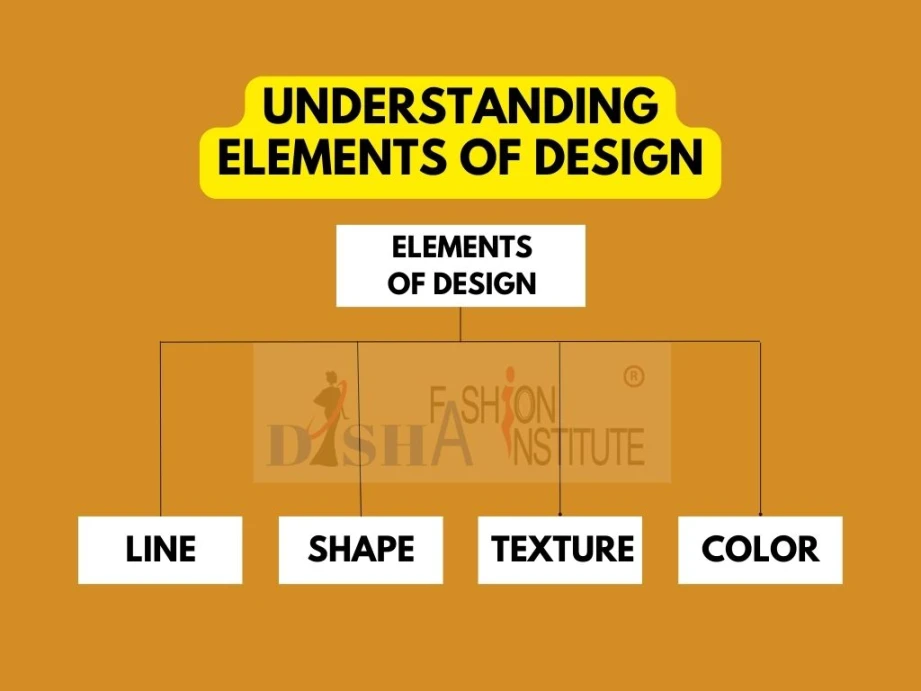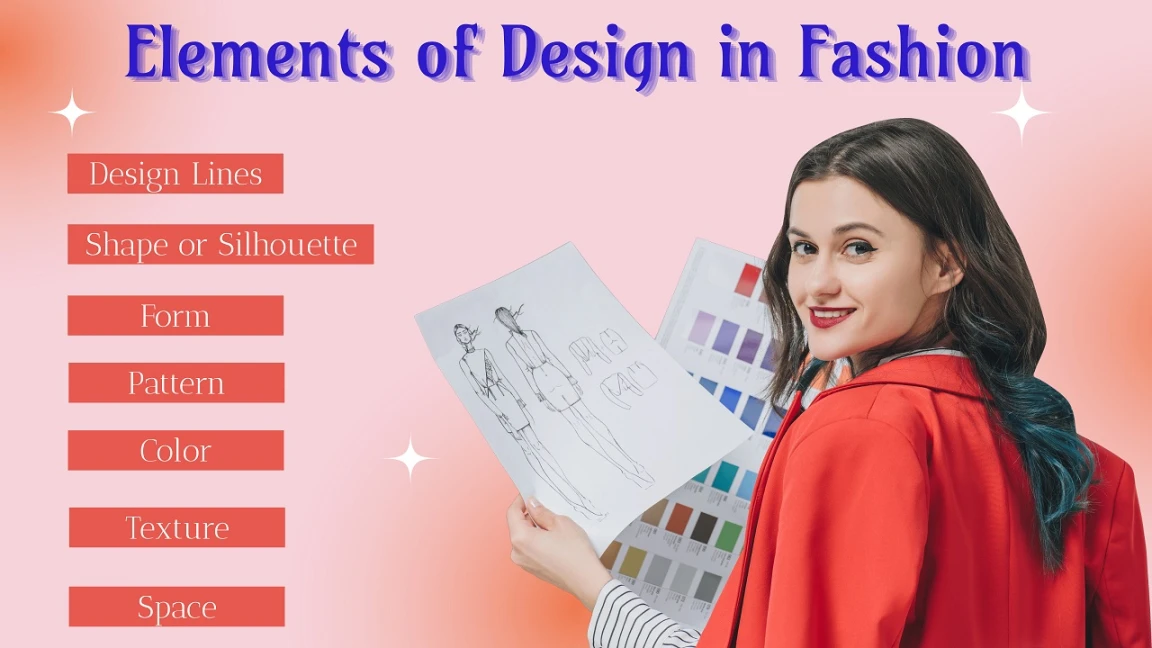Welcome to an exciting journey through the fascinating world of fashion design. In this blog post, we will delve into the essential elements that fashion designers utilize to create stunning and harmonious designs. Whether you're an aspiring designer or simply someone interested in fashion, understanding these elements will enhance your appreciation and knowledge of the artistry behind every garment.
Table of Content
- Basic 4 Elements of Design in Fashion?
- Elements of Design: Lines in Fashion
- Elements of Design: Shape in Fashion
- Elements of Design: Texture in Fashion
- Elements of Design: Colors in Fashion
- Elements of Design: Form in Fashion
- Elements of Design: Space in Fashion
- Elements of Design: Patterns in Fashion
- Explore Free Courses
- Join Fashion Designing Course
Basic 4 Elements of Design in Fashion?

The elements of design in fashion refer to the fundamental components or building blocks used by fashion designers to create visually appealing and well-balanced garments and ensembles.
There are basic 4 elements of design in fashion. Those are Line, Shape, Color and Texture. There are additional 3 important elements of design. Those are Space, Form and Pattern.
Each element plays a crucial role in shaping the overall aesthetic and impact of a fashion design. By skillfully utilizing these elements, designers can achieve harmony and visual interest and convey specific messages or emotions through their creations.
Fashion design is a complex art form that incorporates a variety of elements of design in fashion as well as the principles of fashion design. So, a successful and good design is achieved when all the elements and principles of design work together harmoniously with the theme of the garment is carried out.
Always remember the below formulae to become a successful fashion designer.
‘Principles of Fashion Design’ + ‘Elements of Design in Fashion’ + ‘Harmony’ = A successful and beautiful design
At the end of this blog post, you will understand what the ‘Elements of Design in Fashion’ is in the above formulae. The ‘Principles of Fashion Design’ and ‘Harmony’ have been discussed in other blog posts.
Principles of Design in Fashion
However, the ‘Principles of Fashion Design’ and ‘Harmony’ cannot be explained without being delved into ‘Elements of Design in Fashion’ so we recommend reading this first.
Elements of Design: Lines in Fashion
The line refers to the direction of the lines created by the prints, seam lines, hemlines, dart lines, folds, tucks, and drapes of a garment. It can create direction, movement, and rhythm in a garment. It is the most basic element of design because it divides the total area into shapes and spaces. A line can be hard or soft, either flexible or rigid through its shape, color, and direction. Besides, lines can create the illusion effect of narrowness and fullness of the wearer in the viewer’s eye.
Explaining the concept of line in a single blog section is quite challenging. However, we have dedicated an entire blog post to comprehensively cover all aspects of lines, including their significance and the optical illusions they create. Through the use of vivid pictures and engaging videos, we have illustrated various concepts related to lines in fashion design.
Elements of Design Lines in Fashion
Furthermore, we conducted several experiments to explore the effects of lines and the intriguing results are shared in the dedicated blog post. It promises to be an exhilarating and captivating topic, providing valuable insights into the role of lines in fashion design.
Design Lines and Optical Illusions
Elements of Design: Shape in Fashion
Shape refers to the overall silhouette of a garment. It can be influenced by factors such as the cut, style, and fit of the garment. Designers use this silhouette to outline the basic designs of a garment. Read our full blog post to understand space and silhouette in detail.
Elements of Design Shapes in Fashion
Elements of Design: Texture in Fashion
Texture refers to the tactile quality of a garment. It can be created through the use of different materials, weaves, or techniques. Designers use texture to create interest, depth, and dimension in their garments. They consider the functional aspects of texture, such as the breathability or durability of different fabrics.
Elements of Design: Colors in Fashion
Color as an element can create mood, convey emotion and draw attention to certain areas of a garment. Colors are used to create contrast, harmony, balance, and emphasis in garments. Designers use color theory, such as complementary or analogous color schemes to create visually pleasing combinations or can use bold and vibrant colors to create a statement piece or subtle colors for a minimal look. They also consider the cultural and historical meanings associated with different colors when designing their collections. For example, red is the symbol of love and passion, so in India, bridal attires are usually made of red color.
Color Psychology in Fashion Design
Elements of Design: Form in Fashion
The form is one of the fundamental elements of design, along with line, color, texture, and shape. It relates to the three-dimensional nature of an object, including its volume, mass, and structure. Form basically refers to the visual and physical appearance of an object or composition. In the case of fashion design, it refers to the 3-dimensional shape and structure of a garment or fashion item. The 2 dimensional shapes that we discuss above when takes 3rd dimension become mass or form. So just like the shape, form plays a crucial role in creating visual interest in a garment.
It encompasses the way the garment fits and drapes on the body, as well as its overall silhouette, volume, and proportions. It involves understanding how different fabrics and materials interact with the body, as well as the construction techniques used to shape and manipulate the fabric.
Elements of Design: Space in Fashion
In fashion design, space is considered an element that refers to the physical and visual areas around and between various design elements, such as garments, accessories, and details. It plays a significant role in creating balance, emphasis, and overall visual impact in fashion compositions.
Types of spaces
Positive Space
Positive space refers to the occupied area within a fashion design. It encompasses the actual garments, accessories, and design elements that are visually present and take up physical space. Positive space includes fabrics, textures, patterns, colors, and any other elements that make up the visible aspects of the design.
Negative Space
Negative space, also known as white space, is the unoccupied or empty area within a fashion design. It is the space around and between the design elements. Negative space provides breathing room, contrast, and visual separation. It helps define and enhance the positive space, drawing attention to specific areas or elements.
Some Key Impacts of Space in Fashion Design
Visual Balance
Space is crucial in achieving visual balance in fashion design. By properly distributing positive and negative space, designers can create a sense of equilibrium and harmony. Balancing the motif placement, size, and proportions of design elements within the space ensures that the overall composition feels visually appealing and well-proportioned.
Emphasis
By manipulating the negative space, designers can focus on specific design elements or areas they want to highlight. Skillful utilization of negative space can enhance the impact and visual hierarchy of the design.
Context and Interpretation
Space in fashion design is also influenced by the context in which the design is intended to be worn or displayed. The space in which the garments will be presented, such as the runway or a retail setting, can affect the design's overall impact. The cultural, social, and environmental context can also influence the use of space in fashion design, allowing designers to create designs that are relevant and meaningful.
Elements of Design: Patterns in Fashion
Pattern refers to the repeating motifs or designs used in a garment. Patterns are used to create rhythm and balance in garments. These patterns vary from small to large, bold, vibrant graphics using different techniques such as screen printing, block printing, embroidery, digital printing, eco printing, discharge printing, heat transfer printing etc.
Elements of Design Patterns in Fashion
Explore Free Courses
Begin your fashion journey with our free fashion design foundation course. Dive into the world of style and creation today!
Fashion Designing Foundation Course
Join Fashion Designing Course
Enrol in our certificate courses for fashion designing and textile designing

